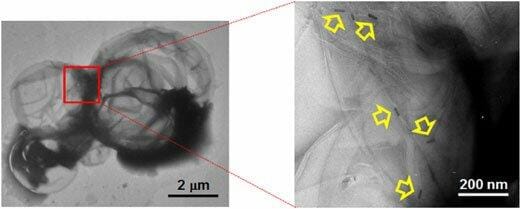Local Anesthesia Release Triggered by Light


Liposomes conjugated with gold nanorods (yellow arrows). Credit: Changyou Zhan, Harvard Medical School.
A team of scientists from Harvard Medical School and the Massachussets Institute of Technology (MIT) have developed a system to release anesthesia locally upon irradiation. Drug administration can be controlled by varying the irradiance and the time of irradiation. The study has been published in the journal Nano Letters.
Systemic administration of analgesics acts on the whole nervous systems and can have side effects like nausea, drowsiness or lack of concentration. Besides, many drugs can’t be taken orally, and some medical conditions require constant delivery of drugs being slowly released for long periods of time. A common alternative is the frequent administration of injections, but this method is very inconvenient for the patient. In this context, some biomedical techniques appeared that allow remotelly controlled drug delivery, by means of near-infrared (NIR) light, magnetic fields or electrical impulses.
Gold nanorods transmit heat to drug-filled liposomes
The team led by Dr. Daniel Kohane was interested in finding a new approach to on-demand drug administration. They developed a system that delivers local anesthesia and can be controlled by the patient himself. The researchers fused gold nanorods to liposomes containing the local anesthetic tetrodotoxin and the adrenergic agonist dexmedetomidine. When NIR light is directed to the area where the nanorods-liposomes complexes are, the nanorods convert light into heat, changing the liposomes conformation and releasing the drugs. Remote NIR irradiation was tested in rats administered with the nanorod-liposome conjugates, and they showed a decrease in sensitivity proportional to the irradiance level.
This innovative nanotechnology would in theory be suitable for excitable tissues like spinal cord, nerve, brain, muscle or heart.
The researchers are currently trying to obtain long-lasting compounds which are also able to release the drugs at lower irradiation levels. This would allow to use less potent lasers or to irradiate for less time, reaching deeper tissues without causing injuries.
Source: nanowerk
